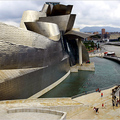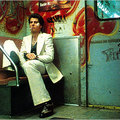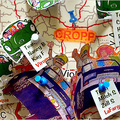FILLED with man-purses and tolerance and kaftans draped on the backs of cafe chairs, should the temperature suddenly drop, Copenhagen is notoriously too civilized. At stoplights, bicycles queue with a Tetris-like geometry, and the natives never jaywalk. (Step into one of their bike lanes, and a Dane might sniff at you; but in three days of walking the expanse of Copenhagen, I never once heard a car horn.) How did a city so orderly, so sleepily self-satisfied, ever produce Soren Kierkegaard?
Kierkegaard was a vain provocateur, a study in flamboyant perversity. The father of existentialism, he asserted the primacy of the individual in all his or her raging contradiction, an assertion he made as emphatically in his personal life as in his writings. He did this first by thrusting himself out into Copenhagen's public spaces, walking its streets so relentlessly, according to the bills from his shoemaker, he regularly wore through his soles. And then, when the city he loved tired of him, and turned him into a figure of public fun, he did it by thrusting himself inward.
Toying with multiple selves, shrinking from others for fear of ridicule, dignifying self-pity as martyrdom — is it any wonder I worshiped Kierkegaard in college? This past fall, I flew to Copenhagen to look for traces of my former hero in interpersonal abjection. The public displays for him are discreet and rare: a few plaques, a statue at the Royal Library gardens, a modest collection of furniture in the Copenhagen City Museum. To find Kierkegaard in Copenhagen — and he is still there — one must ignore the tasteful public homage, and look harder.
I began my search for Kierkegaard in the Frederiksberg Gardens — “that wonderful garden which for the child was the enchanted land where the king lived with the queen,” as Kierkegaard wrote in “Concluding Unscientific Postscript.” In early autumn, it was indeed wonderful. The air was bitingly clear, the grass freshly mown and beneath trees that had been groomed to within an inch of their lives, lovers petted one another to within an inch of theirs. Joggers, geese, sunbathers dotted a greensward sloping up to a beautiful Baroque palace, the old summer residence of Danish royalty. If we are to believe one of his alter egos, it was amid all this unremitting pleasantness that Kierkegaard comprehended “that it was my task: to make difficulties everywhere.”
The story of Kierkegaard and Copenhagen is one of “difficulties,” to say the least. At just the moment Kierkegaard was emerging as the first quintessentially modern philosopher, Copenhagen was emerging as a quintessentially modern city. The daguerreotype and shop-window dressing had arrived in the Ostergade, and its commercial boulevards were now places for strangers to inspect one another, to gossip and seduce. The well-to-do son of a hosiery magnate, Kierkegaard was equal parts fascinated and repelled by the hurly-burly. His hero was Socrates, whom he once called the “virtuoso of the casual encounter,” and Kierkegaard quickly became famous in the city for his own epic strolls, during which he chatted hungrily with everyone he encountered, from the city's elect to the fishwives in the Gammel Strand. “I regard the whole of Copenhagen,” he wrote, “as one great social gathering.”
In many respects, Copenhagen is still the city Kierkegaard knew. “Some of my countrymen probably think that Copenhagen is a boring town and a small town,” Kierkegaard wrote in his “Stages on Life's Way.” “To me, on the contrary, it is the most favorable habitat I could wish for. Big enough to be a major city, small enough that there is no market price on human beings.” True, the hurly-burly has spread since his day, and in ways that would have appalled his fragile sensibilities. In Radhus Pladsen, the heart of modern Copenhagen, the giant mansard roofs are done up like a Nascar driver, bedecked with corporate logos. For much of its length, the pedestrian-only Stroget is fast-food parlors and college kids pretending to be riffraff, that Euro-kitsch that follows you from one European city to another. But what Kierkegaard found in Copenhagen is still here: street bustle if you want it; when exiting the main thoroughfares, a sense of deep, meditative respite.
What fouled so promising a relationship between the philosopher and his city? As a young man, he fell madly in love with Regine Olsen, the fetching daughter of a prominent Danish banker. (On the day he met the 14-year-old Regine — he was 23 — he wrote in his journal, “I stand like a solitary spruce, egoistically unfettered and pointing upwards, throwing no shadow, and no stock-dove builds its nest in my branches.”) He proposed to her, and she eventually accepted. For reasons that have never been made clear, Kierkegaard then decided he could never marry. To end the relationship decisively, he committed to making Regine despise him. He was viciously cold, and to her father he played the part of the scoundrel, even though he remained a devoted celibate. With Regine in near-suicidal despair, and Kierkegaard's name blackened in Copenhagen high society forever, the engagement finally terminated.
Excruciating as the episode was, it may have placed second in Kierkegaard's pantheon of emotional self-torture. In 1845, Kierkegaard received a bad review for “Stages on Life's Way.” He responded savagely, ridiculing the reviewer, and the publication he was most associated with, a satirical paper called The Corsair. “May I ask to be abused,” Kierkegaard mocked. “The personal injury of being immortalized by The Corsair is just too much.” Enraged, the editor of The Corsair responded in kind, attacking Kierkegaard bitterly and repeatedly, in words and drawings; though he brought it upon himself, the “Corsair affair,” as it has come to be known, partly destroyed Kierkegaard. “It was a very decisive and awful experience,” Joakim Garff, the prominent Danish biographer of Kierkegaard, told me. “It confuses and frightens him enormously. The disaster is that he is no longer able to walk up and down the streets of Copenhagen.”
From Frederiksberg, I strolled northeast about 10 minutes to the Assistens Cemetery, and contemplated the final resting place of Soren Aabye Kierkegaard — born 1813, died 1855 — beneath birch trees and the swish of nearby of traffic. From there one can walk east to Peblinge So, one of three capacious lakes in the center of the city where, along its old Lover's Lane, Kierkegaard set the opening of his infamous “Seducer's Diary.” (Something is still in the air. On the dock of a little water cafe, beautiful people lounge on contoured plastic chairs, appraising one another furtively.) From the Peblinge it is a quick walk southeast to pick up the Kobmagergade, a far more placid version of the Stroget, upon which, at the heart of the old city, stands the magnificent Rundetaarn, or Round Tower, where a young Soren was confirmed.
I then followed the Ostergade out into the Kongens Nytorv, a mildly oppressive public square belted by pompous buildings. Here, in the Hotel D'Angleterre, a looming wedding cake of a structure, a young Kierkegaard often came for tea and dialectic. Picking up the Niels Juels Gade, I walked south towards the new Royal Library addition, a black marble-and-glass parallelogram on the waterfront, set on a plaza named after Kierkegaard. Just off its entrance there is a mod café called Soren K, the thought of whose $40 monkfish filled me with Kierkegaardian dread. But just as I was thinking “No no no,” I turned onto the Slotsholmgade, in search of Regine's old family seat. The “six sisters,” a set of row-house mansions, are now gone, but the street is peaceful, and the old bourse building, with its magnificent spire of four intertwined dragon tails, is well worth the detour.
To fully restore my sense of inwardness and melancholy, I followed Kierkegaard's old path, down the Niels Juels Gade, to the Christians Brygge, over the Langebro, or Long Bridge, to Christianshavn, an island of old warehouses that in Kierkegaard's day had fallen on rough times. (After many incarnations, it is now predictably swank, but still a satisfying escape from urban commotion.) Here Kierkegaard would stand on the quay, and contemplate his native city from a distance. “When one stands on the other side, in Christianshavn,” he wrote in his journal, “one seems to be far, very far away from Copenhagen.”
Even after the bitter chastening of the Corsair affair, Kierkegaard continued to walk the streets of Copenhagen. His route often took him past Regine, herself a rambler, and now happily married. The two, Professor Garff told me, “are meeting each other regularly, but they never speak. Kierkegaard has a permanent flirtation with Regine.” Kierkegaard even changed his route, but there still, he found Regine. “I cannot help smiling when I see her,” he wrote in his journal. “Ah! how much she has come to mean to me!” Finally, in 1855, on the day she was to move to the West Indies with her husband, she left her apartment in search of him, and finding him, she finally addressed him directly. “She says: ‘God bless you. I hope it will go well for you,' ” Professor Garff recounted. Eight months later, after collapsing in the street, Kierkegaard died from nervous exhaustion.
On my last afternoon in Copenhagen, I followed the great, sonorous half-note thudding of its bell to the Helligaandskirken, the church where Soren first laid eyes on precious Regine. It is a brick Romanesque building with tall and narrow buttresses. The plaza in which it sits, with its brick paving stones laid out in Victorian fans, is a respite from the nearby Stroget, with its giant poster of Claudia Schiffer, gilded over like a corpse from a Bond film. From the Helligaandskirken, I walked the Stroget to the Vor Frue Kirke, Copenhagen's cathedral. It was near here that Kierkegaard spent his final days. He had battled with church officialdom, often severely. Nonetheless, the building itself he could not relinquish. As he wrote in his “Christian Discourses” of this, the one sheltering interior adequate to his very public misery, “Here in God's house, everything is so still, so safe.”
VISITOR INFORMATION
WHAT TO SEE
Rundetaarn, Kobmagergade 52; www.rundetaarn.dk. This massive, cylindrical tower, dating from the mid-17th century, is one of the old city's most-visited landmarks. Much of Kierkegaard's life unfolded in its shadow, and it affords far and away the best views of the city. (Admission, 20 Danish krone; children, 5 krone, or about $3.65 and $.90, at 5.7 Danish krone to the dollar.)
Helligaandskirken; www.helligaandskirken.dk. The Helligaandshuset, the monastery that adjoins this church, is the oldest church building in Copenhagen, dating back to the beginning of the 15th century, and the best-preserved medieval building in the city. Part of the church was destroyed by fire in 1728, and it was reconstructed in 1880 in a Renaissance style. Here Kierkegaard was baptized, and he continued to frequent the church throughout his life, where he could steal glances at the married Regine.
The Copenhagen City Museum, Vesterbrogade 59; (45) 3321-0772; www.bymuseum.dk, contains a small memorial room to Kierkegaard. Admission, 20 krone; children free. Free on Fridays; closed Tuesdays.
Royal Library, Soren Kierkegaard Plads; (45) 3347-4747; www.kb.dk. His public footprint in Copenhagen has been small, but Kierkegaard finally gets his due in an archive in this sleek new building. Free admission.
WHERE TO EAT
Soren K, Soren Kierkegaard Plads 1; (45) 3347-4949; www.soerenk.dk. Aside from being upscale, this lovely bistro is everything its namesake wasn't: bright, trendy, easy on the eye (500 krone, for a tasting menu without wine).
Noma, Strandgade 93; (45) 3296-3297; www.noma.dk. For a moodier experience, try the exquisite though pricey Noma, in one of Kierkegaard's favorite haunts, Christianshavn, an artificial island filled with ancient warehouses. Noma is in one of these; it is dark, candelit, directly on the canal and the perfect avatar of what the Danish call hygge: a national devotion to the warm, the fuzzy, the cozy. The food is an ethereal interpretation of the otherwise quite rugged cuisine of the North Atlantic. Try the potato chips with red seaweed, fjord shrimps and chicken skins, all dipped in an oyster emulsion and cèpe mayonnaise. You might follow that with sautéed langoustines with oyster and parsley emulsion, rue and seaweed. The seven-course tasting menu is 685 krone, without wine.
Famo, 3 Saxogade, (45) 3323-2250, www.osteriafamo.dk, was started as a laidback alternative to the swanky, and highly regarded, Era Ora, but it's since come into its own as a sweet, unpretentious way to eat a sumptuous Italian meal in Copenhagen. The beautifully balanced tasting menu is 350 krone a person.
WHERE TO STAY
The Guldsmeden hotels (www.hotelguldsmeden.dk), which offer an organic breakfast and wireless Internet, are highly recommended. They range in price from the high-end Bertrams (with doubles at 1,495 krone, with breakfast; singles from 895 krone) to the mid-range Aaarhus (doubles from 1,150 krone; singles from 630 krone). We stayed at the Carlton, which is somewhere in between.
Carlton Hotel Guldsmeden, Vesterbrogade 66; (45) 3322-1500. In the heart of Vesterbro, with its funky shops and cafes, the hotel has 64 rooms done in French Colonial style, and an extremely good organic breakfast buffet. (Doubles from 1,395 krone, including breakfast; single rooms from 795 krone.)






